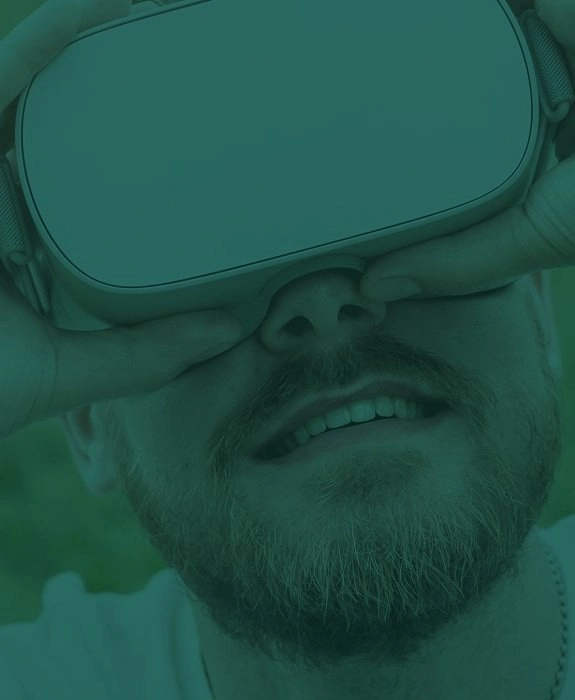Table of Contents
Updated May 2021
From game apps such as Pokémon Go to creative filters (Snapchat, anyone?) to Facebook’s Horizon and Oculus Rift, it seems that both augmented reality and virtual reality are technologies that are set on creating massive disruptions in various sectors. However, what do we exactly mean by these two terms?
Indeed, a lot of people seem to confuse them as being one and the same. While they are both technologies that give you an immersive experience and have similarities in certain aspects, overall, they are very different concepts. In this article, we’ll be giving a detailed breakdown of augmented reality vs. virtual reality as well as helping you decide which is the right one for the needs of you or your business.
Augmented Reality vs. Virtual Reality – the Breakdown
Augmented Reality (AR)
At a Glance
In simple words, AR augments your existing vision by superimposing generated images, models, and holograms in front of it. AR concepts can range from the very basic, such as static filters that stick to your face on your phone screen to more advanced ones such as smart glasses, which places interactable floating app windows and 3D objects to your full line of sight.
Features
For a technology aspect to be considered AR, it must fulfill three basic features, which are detailed below.
- Combination of Real and Virtual Visualization
AR must feature a means to alter one’s perception of the physical world through a seamless interweaving of virtual imagery and animations onto that reality.
- Real-time Interactions
To maximize immersion, virtual components must blend into one’s perception of the real world, not just as simple imagery but also feature heavy integration of interactive elements.
- 3D Registration
Another aspect of enhancing immersion requires an accurate understanding of the spatial characteristic of the real-world vision to ensure the superimposition of the virtual components remains true to the depth, distance, and size of the intended target.
Advantages
- Potent Information Medium
The human mind processes visual information up to 60,000 times better than other forms of mediums such as voice and text. Thus, AR holds the potential of being one of the most powerful means of relaying information to people quickly and effectively.
- Enhanced Learning
Because information gets processed faster, is fully interactable, and context is better and more easily understood, AR can provide a relatively affordable means to facilitate training and learning sessions.
- Improved Productivity
Augmented Reality solutions can reduce delays and interruptions in people’s workflow as it can lessen the need to manually search for new information when coming across a new situation. Timely information can be quickly accessed in real-time and presented visually in the direct vision of the user.
Drawbacks
- Minimal Immersion
While total immersion remains a goal, the technology has yet to advance enough to the point where the virtual part of augmented reality feels ‘life-like’ and naturally fits into our physical reality.
- More Expensive
Compared to VR, AR tools and software generally tend to be more expensive. This is because it relies on the input and processing of a multitude of sensory devices to integrate its virtual elements seamlessly into physical reality.
- Privacy Concerns
An AR app will see what the user sees, and in addition, may collect information on them, raising concerns about privacy.
Virtual Reality (VR)
At a Glance
Whereas when you experience augmented reality, it alters one’s real-world perception, and virtual reality completely replaces it. It presents a simulated experience to the user through a (largely) interactable computer-generated 3D environment. VR utilizes specially made devices such as a VR head-mounted display so the person can have a fully immersive experience in the virtual setting.
Features
To be considered a VR concept, technology must incorporate three basic features, which are detailed below.
- Tracking Element
To better immerse a user in the virtual environment, a VR system must make use of a tracking element that recognizes the user’s movements and makes changes to the environment accordingly.
- Real-time interaction
Similar to AR, VR also features a high level of intractability with virtual elements to enhance immersion.
- Sensory Management System
As a means to further enhance immersion, a VR platform must feature a robust sensory management system that makes the virtual world come alive. It should be able to make the user feel any slight changes to their virtual environment, such as vibrations. However, current platforms feature a more limited capability of this level of immersion.
Advantages
- Better Immersion
Unlike AR, it is easier to immerse a user in a VR setting. There is no backdrop of the complexity of the real world to distract from the virtual setting.
- Enhanced Learning
VR can allow a user to experience situations that otherwise may be impossible, dangerous, or too costly to do so in real-life. VR can allow for better training to be given to professionals who will be tasked to operate in such settings.
- Lower Cost
Compared to AR, VR tends to be typically much cheaper to develop and implement. Developers don’t have to work under the constraints of the real world to facilitate immersion. Dynamically adjusting virtual elements based on input to the virtual environment is simpler than inputting items into the real-world environment.
Drawbacks
- Health Risks
The most obvious drawback to the increased usage of VR is its health risks. Having your eyes glued directly in front of the screen and remaining largely stationary for hours frequently can lead to a number of health-related problems.
- Psychological Risks
VR can negatively impact us on the psychological level in two ways – harming real-world human connections and leading to addiction to the virtual world.
WHICH IS THE RIGHT ONE FOR YOU?
Both AR and VR offer immense potential but also bring with them their own set of opportunities and challenges. Ultimately, if a choice has to be made between the two, it should be dependent on the context in which you or your business operates.
If you want to engage in or deliver applications that often involve or will require interaction with the real world, AR would be better suited. An example would be showing a virtual, 1:1 scaled version of a physical product if you engage in e-commerce. Another would be in the automotive industry, where the driver will be provided essential and critical information directly onto a car’s screen.
Meanwhile, if the applications are for aspects that cannot be or are too costly or impractical to implement in a real-world setting. VR is better for the purpose. An example would include flight training for pilots or in the social sphere, expanding the level of interactions between various users physically divided by geography.
Stay ahead of the game with our helpful resources

4 digital solutions to address common application performance issues
High network latency, memory leaks, slow page loads, heavy CPU usage, and unresponsive servers are all typical performance issues we’ve experienced at some point when using or accessing digital applications. With how easy they occur in projects across verticals, you might be wondering whether the development teams behind these programs have done enough due diligence prior to the release. But human errors and oversight aren’t always the culprit. The reality is that while developers can strive to develop a fully functioning program with virtually no apparent faults upon delivery, no software is truly error-free. Even the most rigorously tested applications

6 useful tips for creating more robust application lifecycle management
As digital technology becomes the norm, software acquisition is now key to gaining a competitive edge in today’s market. Be it as a value offering tailored to consumers or a productivity tool to run complex processes, custom software undeniably helps companies drive growth and deliver value more efficiently. Just as necessary as having a proprietary application is prescribing a standard procedure to govern and maintain its utility. This is to ensure that your business can develop or adopt the right type of software—one that can fully cater to your business needs while keeping disruption to a minimum across critical milestones.

5 major roadblocks businesses must overcome when transitioning into a new software environment
As the business landscape becomes increasingly saturated, staying ahead of the curve often means embracing disruptive technologies to meet the fickle market demands. In most cases, this entails knowing when to pivot your current strategy to an entirely new solution. But recognizing the importance of digital shift is one thing; implementing the necessary IT upgrade is another. A global survey by Deloitte has found that although 87% of companies manage to identify the impact of digital trends on their industries, only 44% have adequately prepared for the coming disruptions. This vast disconnect between organizational expectations and conditions in the field

Is cloud computing the answer to better software development?
Cloud computing is perhaps not a term often heard in daily conversations, but it is one with a far-reaching impact on our technological needs. From expansive options of online data storage to numerous suites of web-based productivity tools like Google Workspace, nearly everyone has used a cloud-enabled technology. Over the last decade, this high degree of versatility also underpins the rapid cloud uptake among businesses. In fact, one survey has found that 94% of companies have already shifted their computing workloads on cloud platforms to varying extents. Unsurprisingly, the market size for cloud technology continues to grow exponentially. With a



